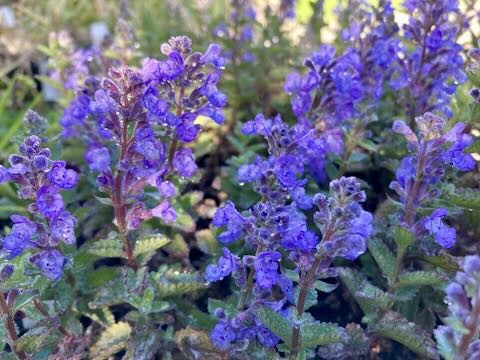
Calceolaria 'Azula'
Firey orange red calceolaria, long lived perennial variety with shrubby growth like salvia or santolina. Trim after flowering to maintain shape and vigour.


A bushy low growing variety with good blue flowers, ideally planted as path edgings or massed beneath roses or in grouped foreground plantings amongst other perennials. Repeat flowers well, so chop hard after first flowering to freshen up and will repeat flower 4 weeks later.
A bushy low growing variety with good blue flowers, ideally planted as path edgings or massed beneath roses or in grouped foreground plantings amongst other perennials. Repeat flowers well, so chop hard after first flowering to freshen up and will repeat flower 4 weeks later.
Data sheet
Firey orange red calceolaria, long lived perennial variety with shrubby growth like salvia or santolina. Trim after flowering to maintain shape and vigour.
A cold tolerant highbush variety with a long fruiting period, reputedly self fertile, however combining varieties improves pollination generally.
A beautiful low compact variety for edging or foreground, virtually evergreen and flowers for a long time. Prefers heavier moisture retentive soil types, and a cooler position is best although will take both full sun or part shade.
A delightful variety for moist fertile soil in shade or part sun, pink flowers and good clumping habit, looks good in both woodland and herbaceous border plantings.
Allium like plant with pink flowers and grassy foliage, tough and long lived, often used in cottage gardens and border plantings
A good plant for medium to heavy soils, flowering in summer with sedums, echinacea, rudbeckia and heleniums; fills nicely in the perennial border and amongst ornamental grasses
A brilliant new cultivar with deep purple flowers. Easily cultivated in fertile moist soil, tall graceful stems.
Select large flowered form of the species, vigorous and long flowering. Medium height bushy plant, earlier than asters but works to same effect amongst other perennials.
White form of the Algerian iris, equally as hardy as the blue forms. Best in free draining soil, colonizes well over time forming grassy mounds flowering in winter. Ideal mass planting under shrubs or specimen plant.
Beautiful variation of the species from Crete, originally from Marcus Harvey. Winter flowering, and a great compact structure plant in rock gardens amongst dwarf bulbs and cyclamen. Low mounding shape with grassy foliage , cold and drought hardy, long lived and only 25cm high. Overall great plant.
Recently imported variety with large semi double flowers like old velvet. Beautiful and long flowering, wonderful with geraniums and heuchera amongst roses..
Useful to create blocks of colour during summer, when many spring flowers have finished blooming. A useful cut flower, the soft colour tones of yarrow are most welcome in mixed bunch combinations.
Attractive multicoloured variety, which starts off as lime green and cream then ages to pink or pale blue depending on soil pH. Morning sun only, best in part shade with good drainage.
Low growing silvery grey foliage variety which is evergreen in mild climates, long lived and drought hardy, useful in mediterranean gardens with gaura, rosmary and wallflowers.
Pink form of Astrantia major: a good companion for hostas and dicentras in woodland.
One of our favourite late season rudbeckias, a tall late summer flowering variety with lemon yellow green centred flowers on strong rigid stems, ideally suited to heavier soil types.

A bushy low growing variety with good blue flowers, ideally planted as path edgings or massed beneath roses or in grouped foreground plantings amongst other perennials. Repeat flowers well, so chop hard after first flowering to freshen up and will repeat flower 4 weeks later.